10 Smart Retainer Management Software for Billing in 2025
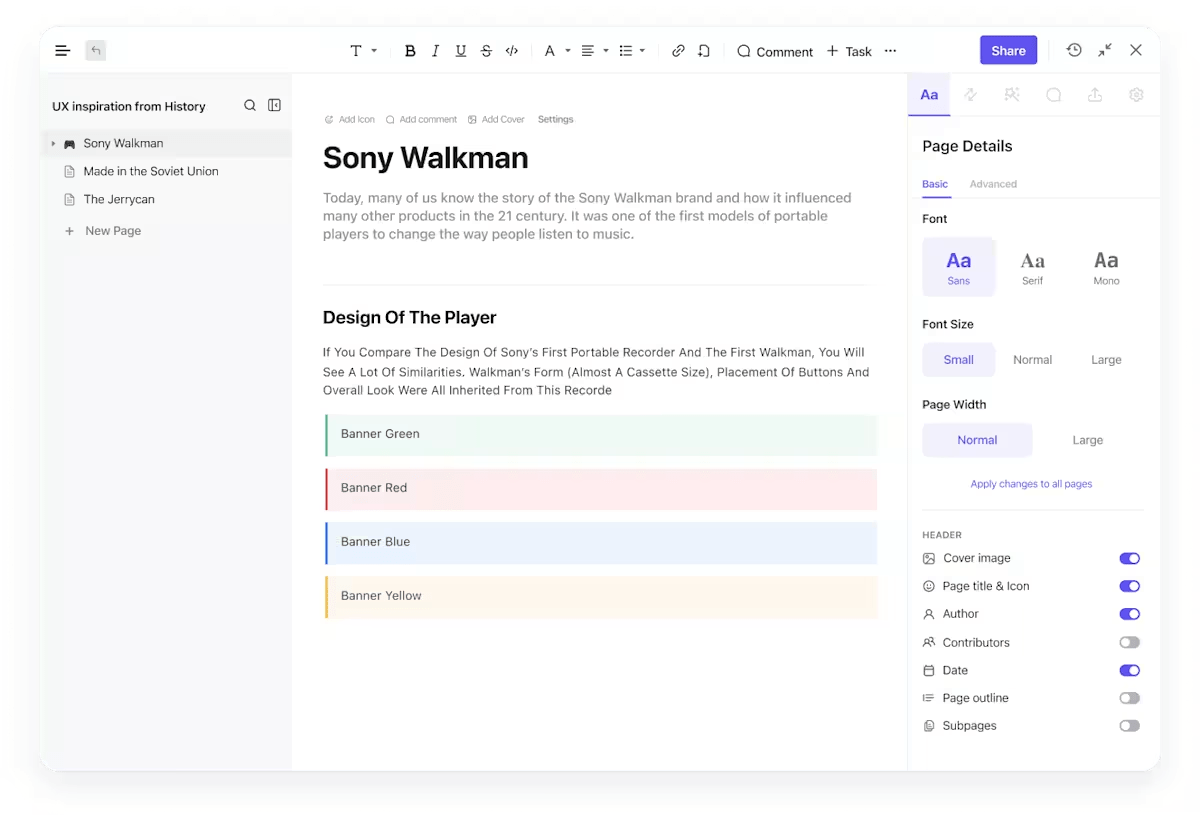
Sorry, there were no results found for “”
Sorry, there were no results found for “”
Sorry, there were no results found for “”

Ask any agency or consultant, and they’ll tell you that acquiring new clients is far more expensive than retaining existing ones. If your team isn’t actively managing ongoing client work or focusing on client satisfaction, it will eventually show—especially in your cash flow. This lack of structure affects client satisfaction and ultimately your revenue.
In fact, acquiring a new customer can cost five to seven times more than retaining an existing one.
To improve retainer agreements and manage retainers efficiently for creative agencies, here’s a compiled list of the top retainer management software to help you handle recurring client work and maintain long-term client relationships.
Here’s a quick comparison of the top retainer management software to help you choose the right fit based on key features, additional features, pricing, and user ratings.
| Tool | Best Feature | Primary Use Case | Pricing |
|---|---|---|---|
| ClickUp | Docs, Templates, Time Tracking, Dashboards in one workspace | Retainer management + project execution in a single, collaborative platform | Free forever; Customization available for enterprises |
| Accelo | Full quote-to-cash lifecycle with client portals | Automating retainer billing, tracking, and client operations end-to-end | Custom pricing |
| Scoro | Financial dashboards and margin tracking | Agencies managing budgets, forecasts, and profitability alongside retainer projects | From $23.90/month per user |
| Paymo | Live time tracking + recurring invoicing | Linking billable hours to automated retainer invoicing with task tracking | Free; Paid from $5.90/month |
| FunctionFox | CEO Desktop + retainer budget tracking | Creative teams handling recurring clients with a focus on hours, scope, and reporting | From $12/month per user |
| Toggl Plan | Team timelines with capacity and visual scheduling | Small teams coordinating workload across retainer projects with clarity | Free; Paid from $10/month per user |
| Hubstaff | Time tracking with productivity monitoring | Office-based teams tracking hours, activity, and budget on retainers | Free; Paid from $5/month per user |
| Wrike | Advanced permissions + AI + risk prediction | Enterprise teams needing secure and scalable retainer workflows | Free; Paid from $10/month per user |
| Zoho Projects | Task + budget tracking with AI assistant | Small teams needing affordable time + task + invoice tracking | Free; Paid from $4/month per user |
| Proposify | Proposal creation + analytics + eSignature | Sales and client teams managing proposals, renewals, and retainer presentations | From $29/month per user |
Choosing the right retainer management software can help you build those tricky long-term client relationships and create a seamless workflow.
The biggest struggle when dealing with repeat customers is that all information is laid out on spreadsheets, making it difficult to make informed decisions. So, ideally, look for features that simplify retainer billing, improve cash flow management, and reduce administrative tasks tied to ongoing client work.
Here’s what to prioritize for winning client retention strategies:
✅ Track retainer budgets, monitor retainer usage, and establish a payment structure while setting alerts for unused hours or approaching limits
✅ Integrate time tracking with invoicing to automatically generate bills for completed tasks
✅ Automate the invoicing process with support for different retainer models, including fixed price or evergreen retainers
✅ Access real-time insights with dashboards showing usage, performance, and client data
✅ Offer a client-facing portal for improved transparency and to enhance client satisfaction
💡 Pro Tip: Struggling with unpredictable income as a consultant? How Do Retainers Work for Consultants shows you how to secure steady, recurring revenue with the right retainer setup.
Our editorial team follows a transparent, research-backed, and vendor-neutral process, so you can trust that our recommendations are based on real product value.
Here’s a detailed rundown of how we review software at ClickUp.
The best retainer management solutions integrate with your project management tools, automate time tracking, and provide real-time insights into retainer usage.
Here are 10 tools that deliver all of that—and more.
Integrating your retainer management software with your project management system is critical. Yet, many agencies still face gaps when key information is scattered across tools.
ClickUp bridges that divide by transforming your project management workspace into a fully functioning retainer management hub within one platform. Here’s how all the features come together.
Align your team with ClickUp Docs
Each retainer period should reflect updated services, deliverables, pricing, and retainer terms to ensure alignment between your team and the client. ClickUp Docs makes creating, revising, and sharing retainer agreements from your workspace easy.

You can connect each Doc to relevant tasks and timelines for context-rich collaboration.
Standardize your processes with ClickUp Templates
Once your retainer model is structured, you can build ClickUp Templates for onboarding, service packages, or project plans. This method standardizes workflows across clients, reduces manual effort, and helps your team focus on delivering rather than setting up.
💡 Pro Tip: If you want to ensure legal protection for consultants and clients, ClickUp’s Consulting Agreement Template is the way to go.
This consulting template standardizes terms related to scope, payments, and responsibilities, helping reduce misunderstandings and setting the foundation for a smooth, professional relationship.
Track your team’s input with ClickUp Time Tracking
With your workflows in place, it’s time to monitor hours spent on ongoing client work. ClickUp’s Time Tracking feature logs hours directly within tasks, helping you automatically generate invoices that reflect actual effort.
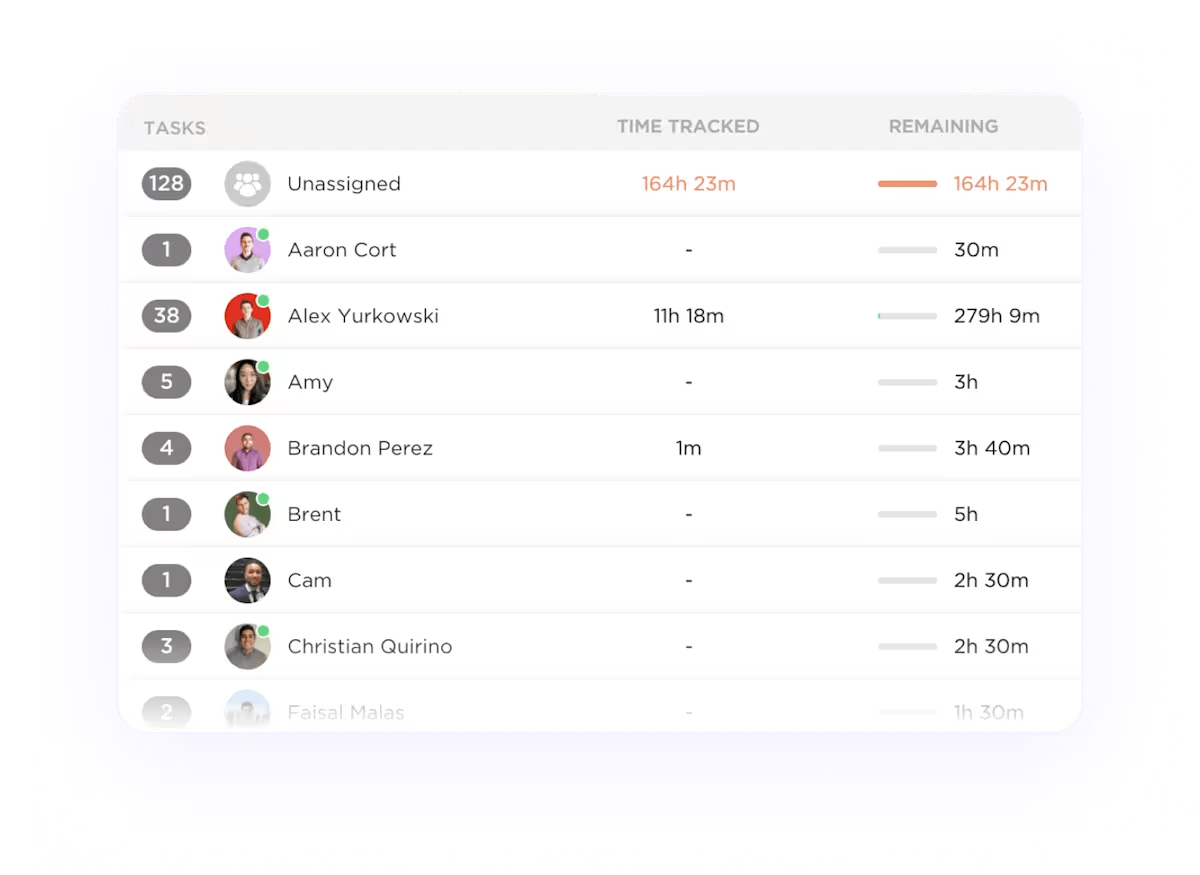
This step is critical for ensuring that clients pay for completed work—and that no unused hours are missed.
Prevent burnouts with ClickUp Views
You’ll want to redistribute leftover time or bandwidth as contracts evolve or close. ClickUp’s Workload and Box View lets you rebalance your team’s time, avoiding gaps in productivity and keeping your retainer projects staffed efficiently.

Break down tasks and share feedback with ClickUp Tasks and live collaboration
Once your projects are live, use ClickUp Tasks to break down each deliverable, assign dependencies, and prioritize work across the retainer period. Since every task is connected to your Docs, timelines, and time logs, your team always knows what’s next.
With resources aligned and tasks underway, you’ll need to ensure everyone stays connected.
Whether it’s your internal team, freelancers, or clients, ClickUp’s collaboration tools—live editing, task comments, and real-time updates—support consistent communication across all ongoing work.

Get 360-degree project progress with ClickUp Dashboards
Lastly, as the work progresses, visibility becomes essential. ClickUp Dashboards provide real-time insights into retainer usage, deliverables, time tracked, and status updates—helping you demonstrate value and improve client satisfaction.

Here’s a quick guide to use ClickUp Dashboards for maximum output.
ClickUp for freelancers is another helpful way of organizing client projects, managing ongoing deliverables, and staying in control of your freelance workflows. From intake forms to time tracking and automations, freelancers can simplify every part of client work without toggling between tools.
💡 Pro Tip: Juggling multiple clients without dropping the ball? Best Project Management Software for Freelancers helps you find tools to stay organized, meet deadlines, and keep every project on track.
💜 Bonus: ClickUp Brain Max: Supercharge retainer ops with Talk to Text
Turn every client touchpoint into billable clarity. With Brain Max on desktop, use Talk to Text to capture client calls, standups, and voice notes, then instantly:
Result: cleaner handoffs, accurate billing, and faster month-end reports—without living in spreadsheets.
A G2 user says:
ClickUp is a custom solution to a wide variety of problems that my company needs to solve. We’re able to track projects in an efficient and collaborative way that keeps everyone organized and on the same page, while also keeping important information any of our users might need access to to complete a task.
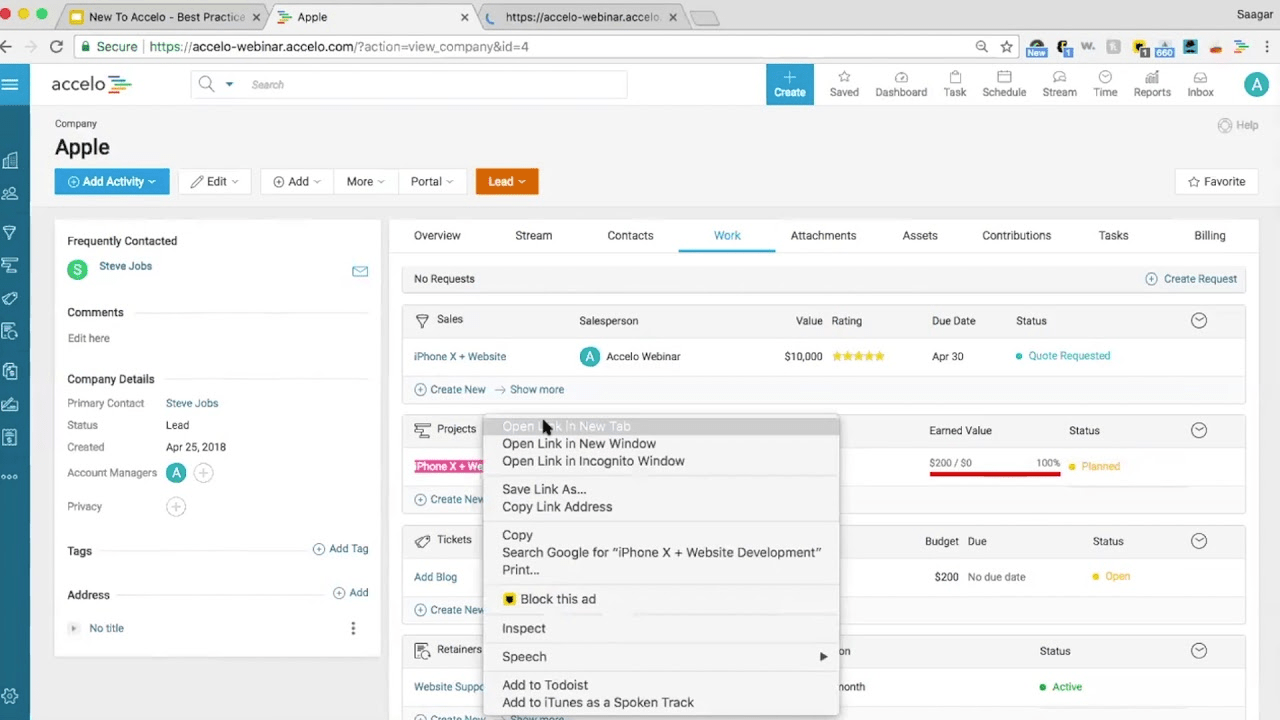
One of the greatest challenges in retainer management is unifying every stage of the client lifecycle—scattered tools for quoting, disconnected project tracking, delayed invoicing, and messy spreadsheets for retainer usage.
This fragmentation wastes time, increases errors, and makes it harder to deliver consistent value to retainer clients.
Accelo solves these issues with a true quote-to-cash platform that centralizes everything—from initial proposals and retainer agreements to task execution, time tracking, and billing.
Explicitly designed as a consultancy software for service businesses, Accelo combines operations, delivery, and finance so your team can manage ongoing client work in one place.
A Capterra user says:
Accelo is great since it allows us to organize all of our customer information in one place, including notes, invoices, payments, and open tasks.

One of the hardest parts for agencies handling retainer agreements isn’t tracking time—it’s tracking money.
That’s where Scoro stands out: this software integrates project management and financial control into one system, giving users full visibility into revenue, costs, and time spent before the invoice ever goes out.
Instead of juggling spreadsheets and tools, Scoro helps you build quotes, assign tasks, track time, and generate invoices—all while comparing planned budgets to actuals in real time.
A G2 user says:
I appreciate Scoro’s quotation functionality as it facilitates the creation of standardized quotes for our clients. The template approach enhances our efficiency by allowing us to swiftly and effortlessly acquire pre-designed project designs.
✨ Fun Fact: In the 1980s, the marketing world shifted from merely acquiring new customers to building lasting relationships with existing ones. This approach, known as relationship marketing, emphasizes customer satisfaction and loyalty as key components of long-term business success.
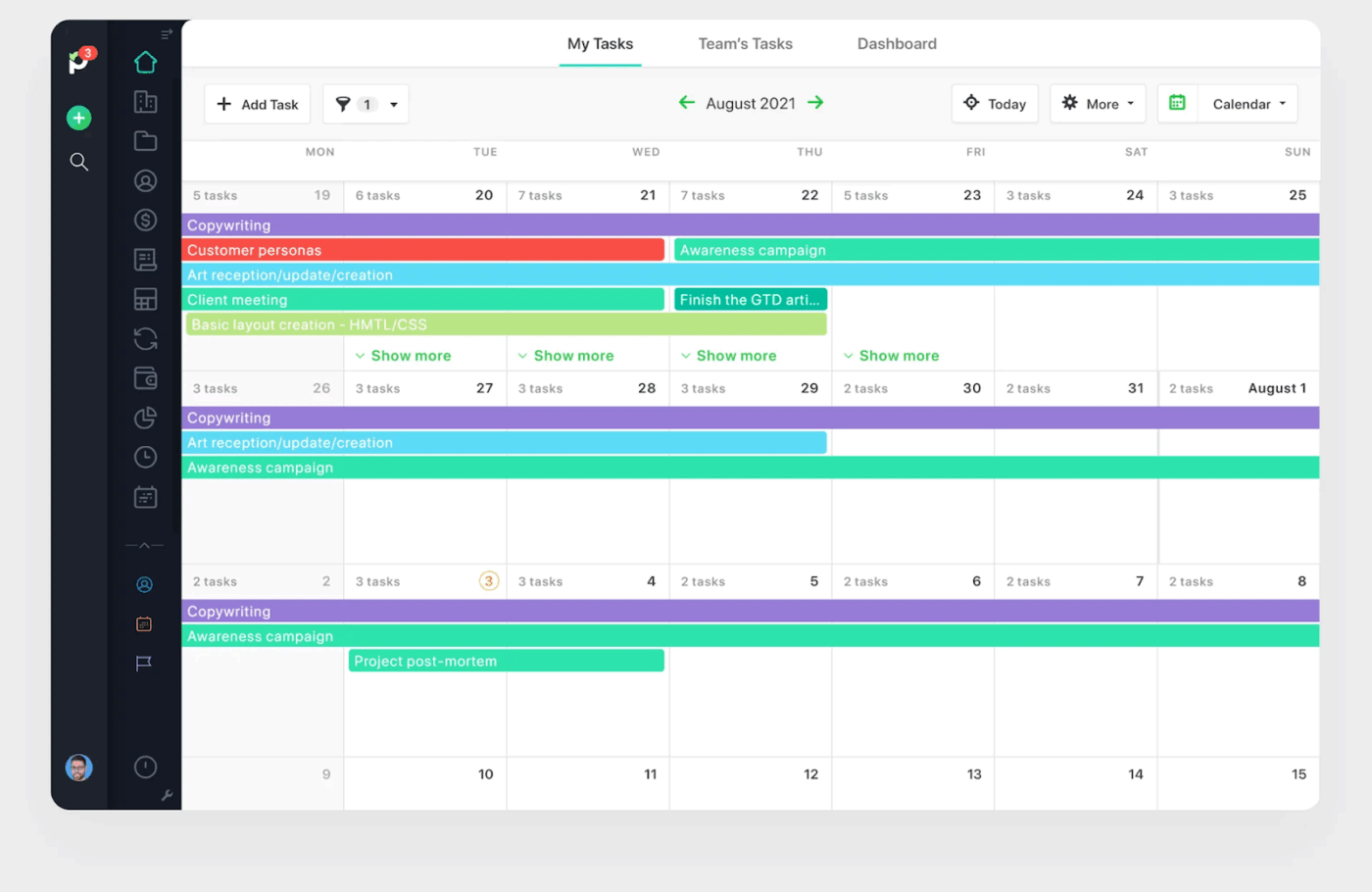
Managing retainer projects often means battling fragmented workflows—especially when time tracking and invoicing are handled in separate tools.
This disconnect leads to inaccurate billing, missed hours, and cash flow delays. Paymo stands out by tightly integrating time tracking, task execution, and retainer billing into a single, clean interface.
Unlike most retainer management software, Paymo’s built-in timer connects directly to invoicing, allowing you to track time, assign billable rates, and automatically generate recurring invoices without switching platforms.
A Capterra user says:
Easy to track time and see calendar view on timesheets to visualize your day. Easy to create a project, and great to see different viewing options such as table or Gantt, depending on how you need to visualize a project.
📖 Also Read: Top Paymo Alternatives and Competitors
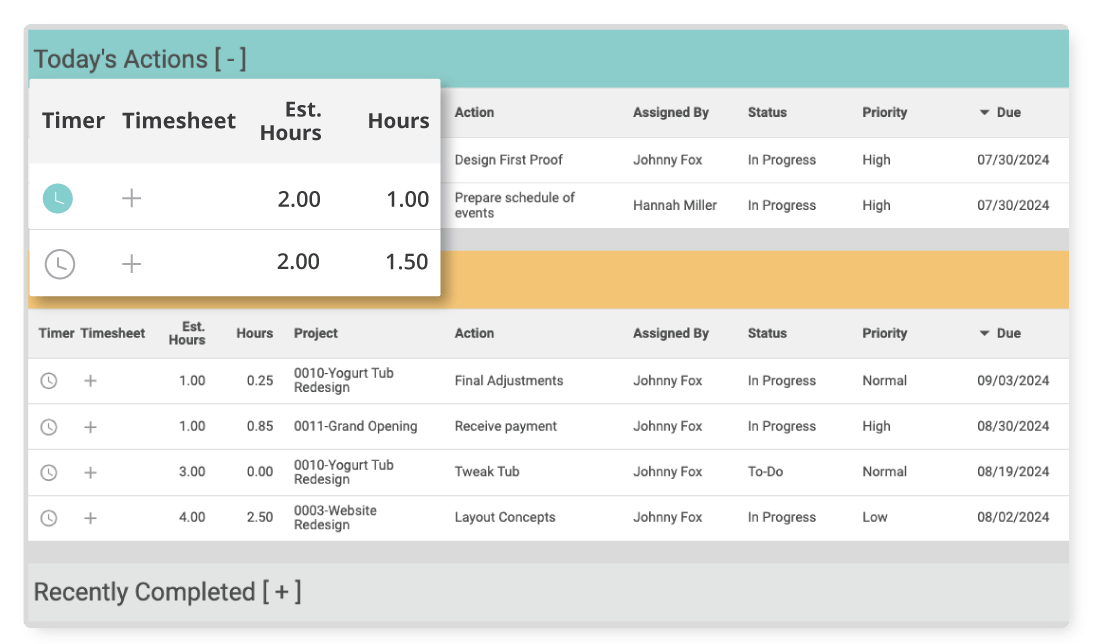
FunctionFox tackles common retainer challenges by offering a streamlined system designed specifically for creative professionals who need clarity across time tracking, budgeting, and project updates.
Whether you’re dealing with fixed-fee service packages or monthly retainer fee billing, the platform provides detailed retainer usage tracking.
FunctionFox also comes pre-loaded with built-in timesheets and automated reminders to help you stay ahead of the retainer period and prevent unused hours from being wasted.
A G2 user says:
I really liked the overview of the schedule. I could see through visual cues how much work was assigned to each of my employees each day. It enabled me to see where bottlenecks or delays might occur.
📮 ClickUp Insight: A third of our respondents say they’re especially interested in using AI for skill development. For instance, a non-technical team member might want to generate the basic code for a webpage with AI’s help.
In these scenarios, AI performs best when it understands your work context—and that’s where ClickUp stands out. As the all-in-one work platform, ClickUp’s AI is aware of your projects and can suggest tailored actions or even handle tasks like generating code snippets with ease.
💡 Pro Tip: Want to boost your credibility and stand out in a competitive consulting market? Consulting Certifications to Build Your Career, along with ongoing support, highlights the most recognized certifications to elevate your expertise and establish client trust.
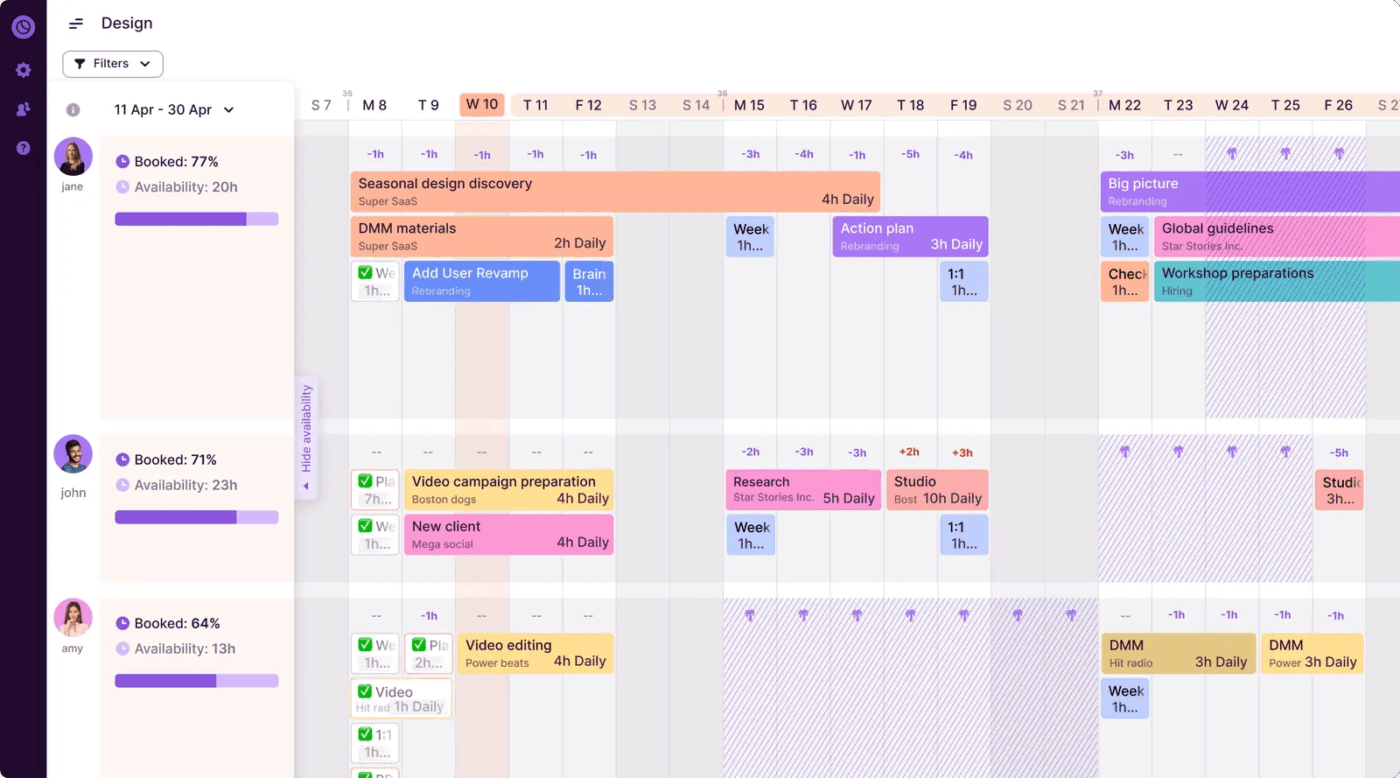
When small teams deal with overlapping deliverables, here’s a common scenario that takes place: you might know what needs doing—but not when, by whom, or how it affects the rest of the team.
Toggl Plan is built to solve this exact problem by offering a visually appealing work planning tool that prioritizes timelines, availability, and task ownership.
Unlike traditional retainer management software or task trackers, Toggl Plan simplifies coordination with team timelines, availability views, and drag-and-drop schedules.
A Capterra user says:
I’ve been using Toggl track on and off for several years, but this year turning to more payments based on hours worked I am tracking all of my time. The reports are really helping me to understand how I work and to be able to plan my workload and time a bit better.
📖 Also Read: Top Toggl Alternatives for Time Tracking

When projects run long or team productivity drops, it’s rarely due to a lack of effort—it’s usually a lack of visibility.
Here’s how Hubstaff solves that: Built for desk-based and remote teams, this tool combines time tracking, activity monitoring, and project budgeting to give managers a clear window into who’s working, when, and how effectively.
Hubstaff makes it easy to bill accurately, approve timesheets, and trigger payroll through integrations like Gusto or QuickBooks.
A G2 user says:
Time Tracking with Proof of Work. You can track hours with optional screenshots, activity levels, and app/URL usage. It’s perfect for remote teams or freelancers who need transparency.
📖 Also Read: Best Hubstaff Alternatives and Competitors
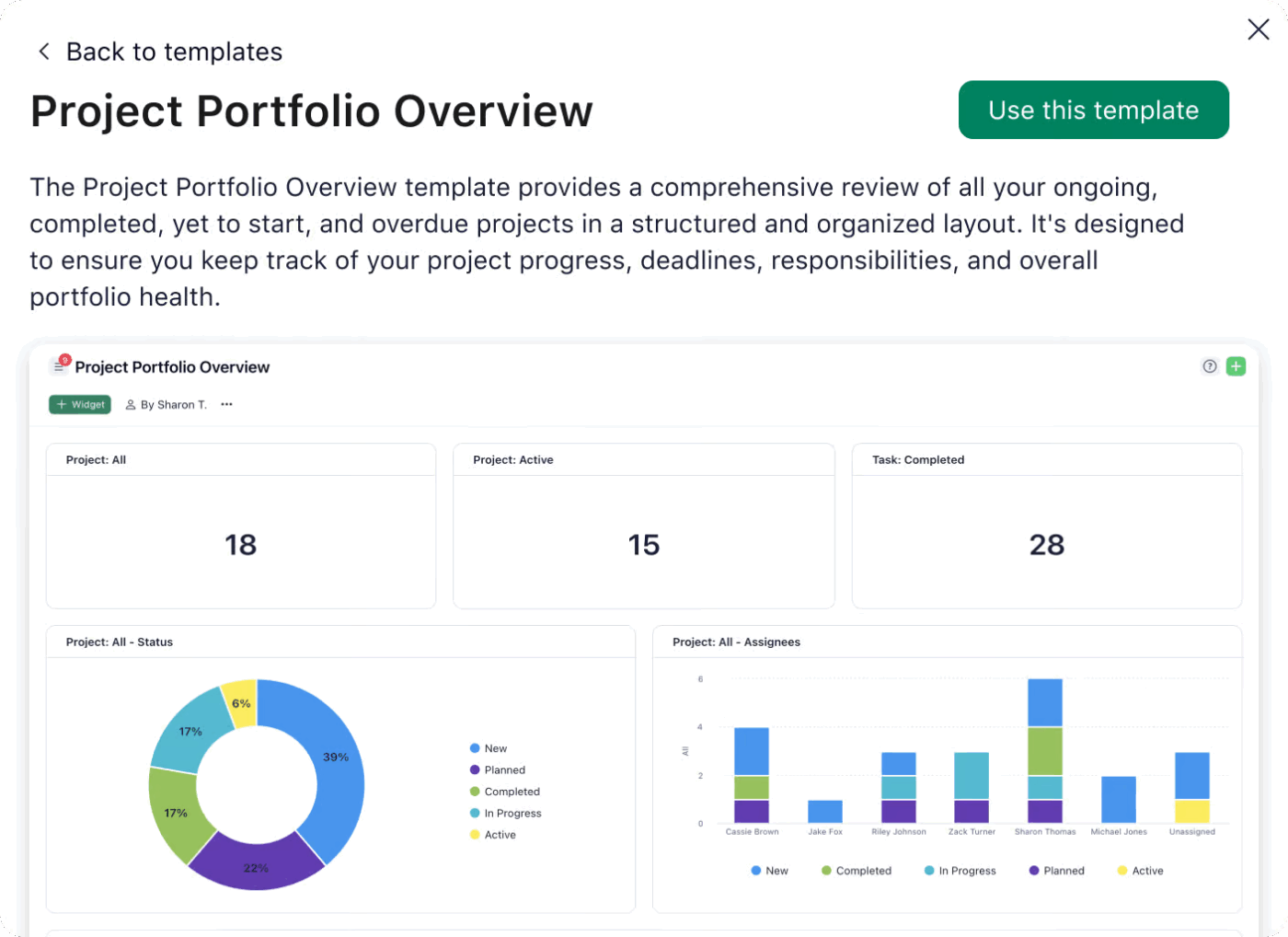
If you’ve ever managed a large project with multiple moving parts, you know how quickly things can spiral—missed updates, unclear responsibilities, and too many tools in the mix.
According to Gartner, this is probably why the business considers around 80% of IT projects failures.
Wrike helps organize chaos. Teams that need strong oversight, such as marketing departments, ops teams, or those in regulated industries, will appreciate the admin controls and security features.
A Capterra user says:
Wrike has enabled us to create a central source of truth and build greater transparency in our project portfolio. The automation has eliminated manual activities, and the ability to integrate with other platforms drives efficiency.
📖 Also Read: We Tested the Best Wrike Alternatives & Competitors
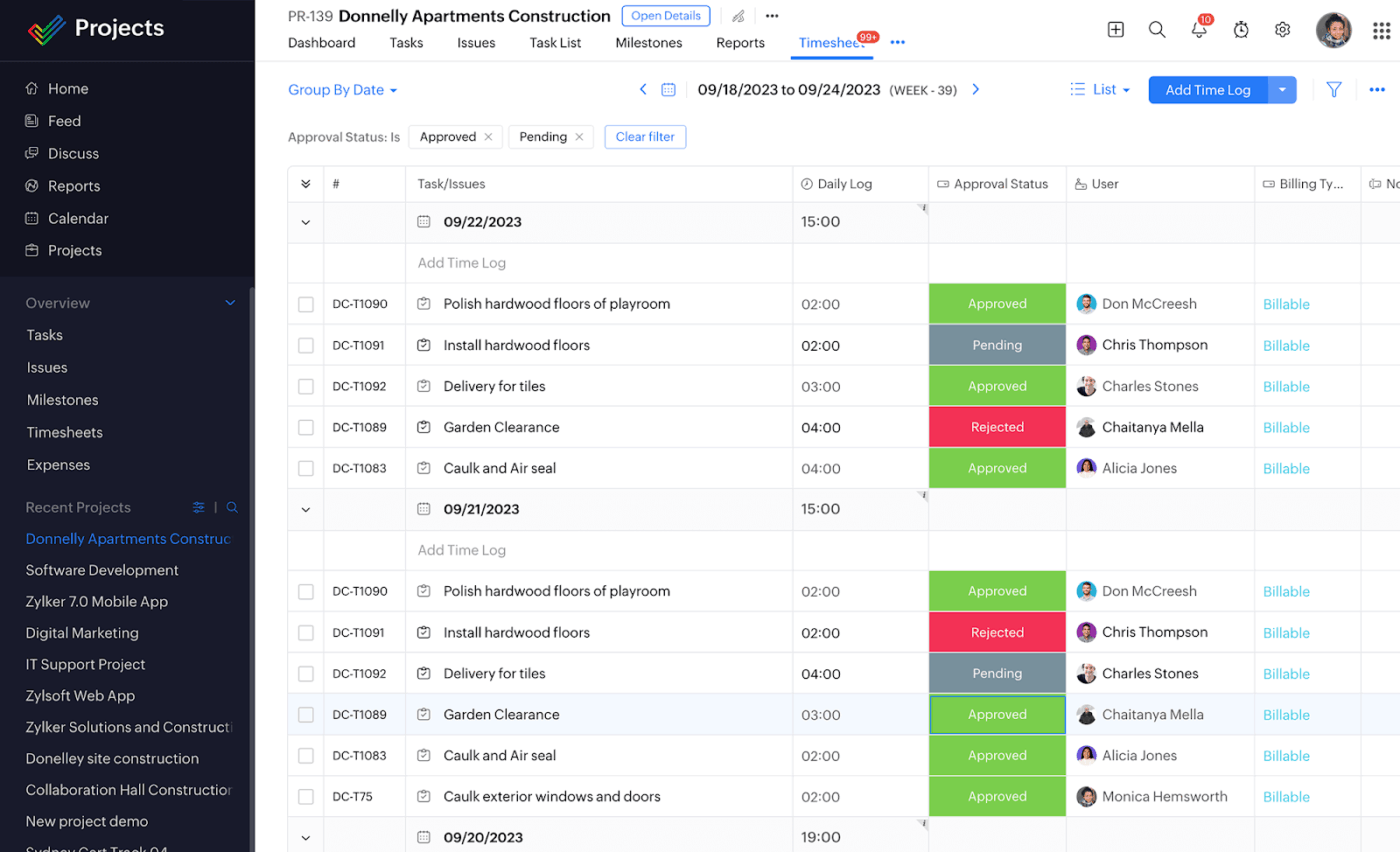
Most project managers are stuck in loops of sticky notes, spreadsheets, and “just one more quick status meeting.”
Despite all this, Zoho Projects may feel like a refreshing change.
Designed with simplicity, it packs in essentials like task dependencies, time tracking, and visual project views—without a steep learning curve.
What makes it stand out? It’s budget-friendly (just $4/user), easy to learn, and even has a built-in AI assistant named Zia to help you manage deadlines and surface insights.
Additionally, it seamlessly integrates if your team already utilizes other Zoho tools, such as CRM or Books.
A G2 user says:
Zoho One has all kinds of modules that a small company would need. From Project management to HR to CRM to online sign-in to email and calendar, surveys, and more. Perfect for an all-in-one system. We use it daily for our whole team.
📖 Also Read: Best Freelance Time-Tracking Software
🧠 Did You Know: 87% of businesses face late payments—and unclear invoices are often to blame. How to bill a clients shows you how to get paid faster with fewer follow-ups.
If you’ve ever scrambled to put together a last-minute proposal in Google Docs and wondered if the client even opened it, Proposify might be of help.
This software is designed for modern sales teams that want to create sleek, on-brand proposals that impress, and track every interaction down to the second.
Additionally, Proposify provides visibility into the complex world of proposal follow-ups. You’ll know who opened it, which section they lingered in, and when they signed.
A G2 user says:
I’ve used every tool and function on Proposify and have never had any trouble getting it to do what I need it to. The stats and metrics we have access to are particularly useful for my team- our sales have doubled since onboarding with Proposify.
💡 Pro Tip: Want to turn your expertise into a full-time consulting career? How to Become a Consultant walks you through every step to land clients, build credibility, and drive real impact.
Here are three additional tools used by agencies and consultants for ongoing client w/ork:
You can probably tell now that retainer management is the backbone of sustainable client relationships and predictable revenue, especially when dealing with a recurring client.
ClickUp helps you achieve that.
From drafting and updating agreements with ClickUp Docs to tracking billable hours and visualizing usage with Dashboards, every part of the retainer lifecycle is accounted for—seamlessly, in one place.
And it’s not just about retaining clients. As Shikha Chaturvedi, Business Analyst at Cedcoss Technologies Private Limited, put it in her review:
We retain all the business problems in one place and can focus on each problem simultaneously through ClickUp. It also helps us manage our tasks and track the time invested in particular tasks.
Start managing retainers the smarter way—sign up for ClickUp today.
It’s a tool that helps agencies, consultants, and service providers manage ongoing client relationships by tracking budgets, automating invoices, and ensuring recurring work is billed accurately.
Consultants, marketing agencies, law firms, creative studios, and freelancers who work with ongoing client contracts.
A retainer ensures a client has reserved access to consultants, marketing agencies, law firms, creative studios, and freelancers who work with ongoing client contracts.
© 2025 ClickUp